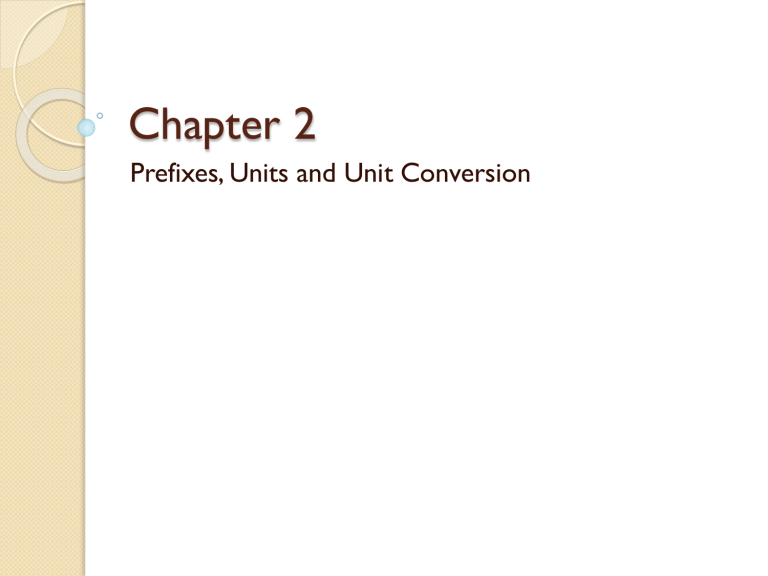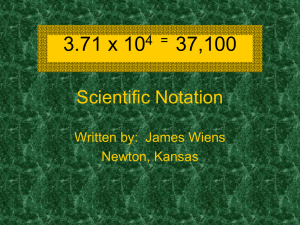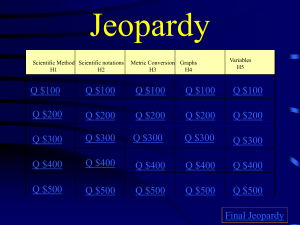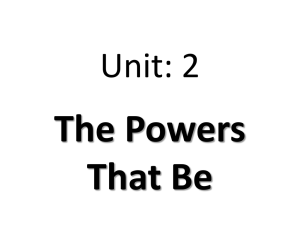Chapter 2 Powerpoint

Chapter 2
Prefixes, Units and Unit Conversion
Quick review on exponents
10 3 = 10x10x10 = 1000 10 x 3
3 x 10 3 = 3x10x10x10 = 3000
2 4 = 2x2x2x2=16
10 6 = 10x10x10x10x10x10 = 1,000,000
10 -3 = 1/(10 3 ) = 1/1000 = .001
10 -6 = 1/(10 6 ) = 1/1000,000 = .000001
5 x 10 -6 = 5 x 1/(10 6 ) = 5x.000001 =
.000005
Scientific Units
Parameter
Length
Unit
Meter [m]
Mass
Time
Kilogram [kg]
Second [s]
For Electronics
Voltage
Current
Resistance
Volt [V]
Amp [A]
Ohm [ Ω ]
Other Units
Prefixes
How many meters are there in a kilometer?
◦ 1000
How many milliseconds are there in a second?
◦ 1000
How many bytes are there in a Gigabyte?
◦ 1,000,000,000
Prefixes (cont.)
Kilo, milli, and Giga are all called prefixes.
Can you guess why they call them prefixes?
Because they come before the unit such as millisecond.
Prefixes are used to represent how much of the particular unit is being represented
Prefixes we’ll use in Elec50A
Prefix Abbrev.
Example What it means
Giga
Mega
Kilo
G
M k
Unit Base -
Milli
Micro m
Or u
Nano
Pico n p
S mg u Ω ns pA
Gm
MV kA x1,000,000,000 x1,000,000 x1,000 x1 x.001
x.000001
x.000000001
x.000000000001
Scientific
Notation x10 9 x10 6 x10 3 x10 0 x10 -3 x10 -6 x10 -9 x10 -12
In your book they show other prefixes we won’t use much if at all.
Quick Prefix Quiz
How seconds are there in a Gs?
◦ 1 billion
How many volts in a mV?
◦ .001
How many mV in a volt?
◦ 1000
How many amps in a kiloAmp (kA)?
◦ 1000
Quick Prefix Quiz (cont.)
How small is a nA
◦ 1 billionth or .000000001 A or 10 -9
How small is a u Ω ?
◦ 1 millionth or .000001
Ω or 10 -6
How big is a pV?
◦ 1 trillionth of a volt or 10 -12 V
3 ways to write a number
Regular Way Using Prefixes Scientific Notation
1 million volts
1 thousandth of an amp
1 millionth of an ohm
1 billion grams
5 thousand meters
1 second
1,000,000 V
.001 A
.000001 Ω
1,000,000,000 g
5000 m
1 s
1MV
1mA
1u Ω
1Gg
5km
1s
1x10 6 V
1x10 -3 A
1x10 -6 Ω
1x10 9 g
5x10 3 m
1x10 0 s
Notice that the prefixes take place of the scientific notation and everything else stays the same. Meaning – k = x10 3
Write the following in scientific notation:
3mV 3x10 -3 V
18kV
43ms
2.1GA
30uA
57ps
18x10 3 V
43x10 -3 s
2.1x10
9 A
30x10 -6 A
57x10 -12 s
Write the following using prefixes
483x10 -3 A
32x10 6 V
2x10 -9 A
3.4x10
-12 s
.350x10
3 Ω
42x10 -6 V
483mA
32MV
2nA
3.4ps
.350k
Ω
42uV
Notice “m” replaced all of “x10 -3 ” and everything else stayed the same
This can be simplified to just
350 Ω
More practice problems -
Converting regular numbers to scientific notation.
Convert 4578 to scientific notation
Convert .00009 to scientific notation
Convert 4.56 to scientific notation
What does 6.4 x 10^0 = ?
4.578 x 10 3
9x10 -5
4.56x10
0
6.4 x 1 = 6.4
Notice in the above example 9x10 -5 cannot be converted to a prefix very easily because there is no prefix for -5. So it is useful to convert this number to one that does have a prefix.
9x10 -5 = .00009 = .000090 = 90 x 10 -6 = 90u
What we just did was convert scientific notation to engineering notation!!! (Go ahead and write home)
So what is the difference between scientific notation and engineering notation?
In scientific notation there is always only one digit or number in front of the decimal and everything else is behind the decimal.
◦ Ex: 9.54 x 10 -5
In Engineering notation the exponent is always a multiple of 3.
◦ Ex: 95.4 x 10 -6
◦ Notice -6 is a multiple of 3
Notice all prefixes are multiples of 3
Prefix Abbrev.
Example What it means
Giga
Mega
Kilo
G
M k
Unit Base -
Milli
Micro m
Or u
Nano
Pico n p
S mg u Ω ns pA
Gm
MV kA x1,000,000,000 x1,000,000 x1,000 x1 x.001
x.000001
x.000000001
x.000000000001
Scientific
Notation x10 9 x10 6 x10 3 x10 0 x10 -3 x10 -6 x10 -9 x10 -12
We will be using engineering notation for electronics courses because it is useful in converting to prefixes.
Convert the following to engineering notation and then to its corresponding prefix
.00043A
= 430 x 10 -6 A = 430uA
23x10 -2 V = .23V = 230x10-3V = 230mV
67x10 7 s = 670000000s = 670x10
.00000783m
= 7.83x10
-9 s = 7.83nm
6 s = 670Ms
Random Video of the Day!
Get out your Calulators
First put your calculator in Engineering
Notation
◦ Press 2 nd F
◦ Press SET UP
◦ Press 1 for FSE (Fixed Scientific Engineering
◦ Press 2 for Engineering Notation
◦ Enter 9 so it shows the most amount of precision
◦ It says ENG on the left side of the screen now.
◦ If you ever want your calculator to show normal looking numbers as answers again, you’ll have to go through this process and press 0 for fixed numbers at the last step.
Enter 567000 and press =.
Notice it automatically put it into
Engineering Notation.
It shows 567E3
E is an abbreviated way of saying “x10^”
567E3 = 567 x10 3
Now press .0000004 and press enter
You may need to press the Change button to convert it from a fraction
It shows 400E-9.
Convert this to a prefix
400n!!!!
Look on Page 21 of your book
Throughout the text book, anytime we will encounter a new feature using the calculator, it will tell you the buttons to press to perform the particular operation.
Convert to a prefix using calculator
.000056V
5430000A
4300 Ω
.00076s
= 56uV
= 5.43MA
= 4.3k
Ω
= 760us
Using a Calculator for this stuff
3 ways to enter these numbers
1.
Entering 5.4x10
3
Just enter 5400
2.
3.
EXP is the same thing as “x10^”
Sometimes 5.4x10
3 can be expressed as 5.4E3.
This is the same thing as 5.4 EXP 3
Converting between units
Many times it is useful to convert from one prefix to another. ie: uA to nA
Convert 43uA to nA
◦ 43uA = 43000nA
To do this we will use 2 rules. WRITE THESE
DOWN!
If you are going from a larger exponent to a smaller exponent, then you move the decimal to the right
If you are going from a smaller exponent to a larger exponent, then you move the decimal to the left
- If you are going from a larger exponent to a smaller exponent, then you move the decimal to the right.
- If you are going from a smaller exponent to a larger exponent, then you move the decimal to the left
.043V
43.uV = 43uV
Convert 72GV into _______nV
72,000,000,000,000,000,000V
- If you are going from a larger exponent to a smaller exponent, then you move the decimal to the right.
- If you are going from a smaller exponent to a larger exponent, then you move the decimal to the left
Now convert to Engineering Notation
10 10x10 3 A
1.5
1.5x10
6 Ω
1.2
5100
1.2x10
3 Hz
5100 x10 -6 A
0.04
1
0.04x10
-3 A
1x10 3 W
.15
.25
3700
1500 1500x10 -12 F
.15x10
3 V
.25x10
6 W
3700x10 3 Ω
Using the table. You have this as a handout
Convert 1 microsecond into ________seconds
Convert 2834.5 nanoseconds into ________microseconds
Explaining Handout – This handout may be used on tests, but no writing may be on it.
Handout
Units Worksheet
Lets do together 1, 2, 10, 11, 17, 22
Go ahead and finish the rest of the worksheet on your own. If you don’t finish it in class it is homework.
Its due on Monday








